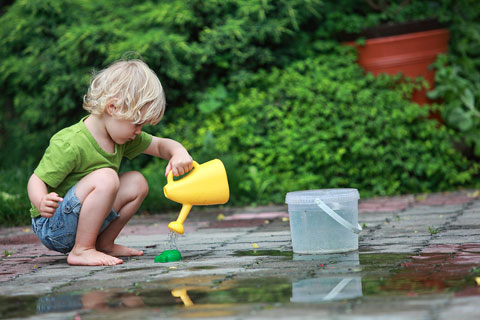Playing with materials such as water can be an important outdoor experience for preschoolers. When children play with water, they can build fine- and gross-motor skills. They can also apply some basic principles of science and engineering.
Help children prepare to investigate water outdoors.
- Share nonfiction books, websites, and videos about water and its behavior. Ask a librarian to help you find pictures of Illinois rivers, lakes, dams, and levees to show the children.
- Invite children to plan and build models of what they see in the pictures. Help them decide what materials to use so they can contain or move water in their models.
- Introduce words such as flow, flood, dam, erode, and contain to help children describe how water moves.
- Suggest that families send “work clothes” for children to wear when they play outdoors with water. Provide plastic gloves for children who want to wear them during outdoor water play.
- Encourage safety and respect for others’ work by asking children to help make rules for water play. Supervise water play carefully. Children should always wash hands after playing in water.
Set aside part of the playground for water study.
- Pick a place where the water play will not disturb children who do not want to be wet. A space with sand or gravel may lend itself well to studying erosion.
- Some children may feel anxious about getting wet, messy, or splashed accidentally by other children. Allow them to practice by playing with indoor water tables that have clean water. Outside, they may prefer their own space away from others as they get used to the experience.
- Provide a source of water that children can use for water play. You could use a plastic beverage cooler with a spout, filled plastic gallon containers of water, a water table from the classroom, or a very shallow wading pool. Make sure that containers are safe (e.g., not too heavy or deep) and clean them appropriately as needed.
- Provide buckets, scoops, measuring cups, ladles, and shallow tubs for moving the water. Offer hoses, turkey basters, lengths of plastic gutter, and PVC pipe, including joints and elbow bends. You might ask families or businesses (garden centers, building supply stores, or contractors) to donate these items.
- Ask questions that provoke children’s curiosity. “Do you think a piece of wood will work as a dam?” “What do you suppose made your levee come apart?” “Can you make this water flow up the hill?”
Follow up on the children’s water experiments.
- Invite children to draw or take photos or videos of what they do with water. Let them report on their water play during class meetings.
- Let children create a display about their water study for visitors to see. They may enjoy showing videos of their water experiments while narrating.
IEL Resource
- Resource List: Science Exploration for Preschoolers


 PDF
PDF